|
Size: 12783
Comment:
|
Size: 12783
Comment:
|
| Deletions are marked like this. | Additions are marked like this. |
| Line 8: | Line 8: |
| * 1h00. Observing. The cryostat is dying, strong oscillations of T on the still (0.3K peak-peak), the trap is the more and more blocked. Signal on Neptune at 2mm around 700Hz. Around 2500Hz on Uranus. Nut non-negligible opacity corrections to be expected (tau=0.3-0.4, EL=30-40 deg). | * 1h00. Observing. The cryostat is dying, strong oscillations of T on the still (0.3K peak-peak), the trap is the more and more blocked. Signal on Neptune at 2mm around 700Hz. Around 2500Hz on Uranus. Nut non-negligible opacity corrections to be expected (tau=0.3-0.4, EL=30-45 deg). |
Back to the NIKA2 run 5 main page
Contents
- September 26, (Monday)
- September 25, (Sunday)
- September 24, (Saturday)
- September 23, (Friday)
- September 22, (Thursday)
- September 21, (Wednesday)
- September 20, (Tuesday)
- September 19, (Monday)
- September 2016, 18 (Sunday)
- September 2016, 17 (Saturday)
- September 2016, 16 (Friday)
- September 2016, 15 (Thursday)
September 26, (Monday)
- 1h00. Observing. The cryostat is dying, strong oscillations of T on the still (0.3K peak-peak), the trap is the more and more blocked. Signal on Neptune at 2mm around 700Hz. Around 2500Hz on Uranus. Nut non-negligible opacity corrections to be expected (tau=0.3-0.4, EL=30-45 deg).
September 25, (Sunday)
- 8h30. Temperature around 200mK. Reached 175mK during the night but the big trap is blocking also. Seems (hope) to be OK for today at least. Tomorrow, in view of the coming run, we have to warm up a bit and clean the traps. Working on trace now.
- 9h-12h. Difficult to produce the param file for the 2mm. The "resonances array 2" did not work properly. I did box-per-box and then added the OFF by hand on the file (!!). We have in total 580 KID and 36 OFF. Most of the KID are good despite we have a large correlated noise that in my opinion is related to the cryostat (270mK).
13h. Replaced AMC 179: #26 is replaced by #14. Done in the router. Still not working. IT MEANS THE PROBLEM IS IN THE SLOT OR THE RACK OR THE SOFTWARE ??? We start observing without the T. Looking back at an old ELOG entry (https://lpsc.in2p3.fr/elog/NIKA/314) I see that in fact the slot 9 of that rack didn't work properly. So THE MISTERY IS SOLVED, at the end of the first observation run at 17h I will change the position of that board and make a new param for Tamc.
- 14h. After all the mess in the last week we finally see the Sky. See Mercury (200Jy) below seen under tau 0.6 (at least) and EL=40DEG. S/N is above 1E4 assuming good decorrelation.
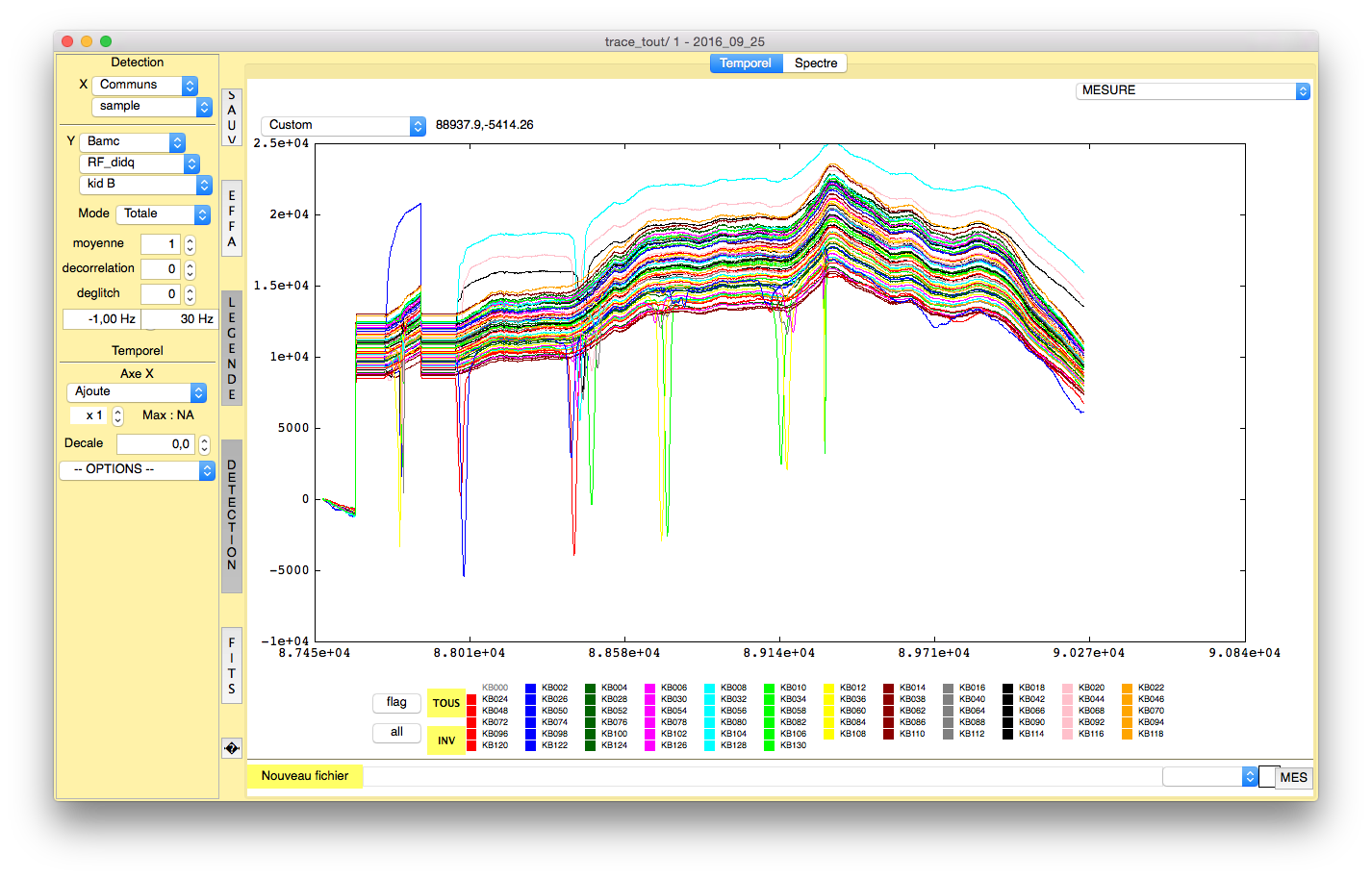
- Here a few preliminary plots. We started observing with (0,0) Nasmyth offsets, (0.0) pointing offsets and focusZ=0. The first map showed we were off-centered by about 20 arcsec. After a few failed files, we performed a focusOTF-Z sequence to optimize the focus a bit (based on last run's kidpar and array 1 geometry) before doing a beammap. We found that we had to observe at z=-0.5. Here are the plots of the focusOTF sequence to illustrate this, but with the kidpar that was derived later on the beammap (hence the 2mm map...). The FWHM are larger than expected, but the geometries are approximative at this stage, no pointing correction is applied, the weather was not excellent (see the beammap plots below), so... The beam is elliptical though.
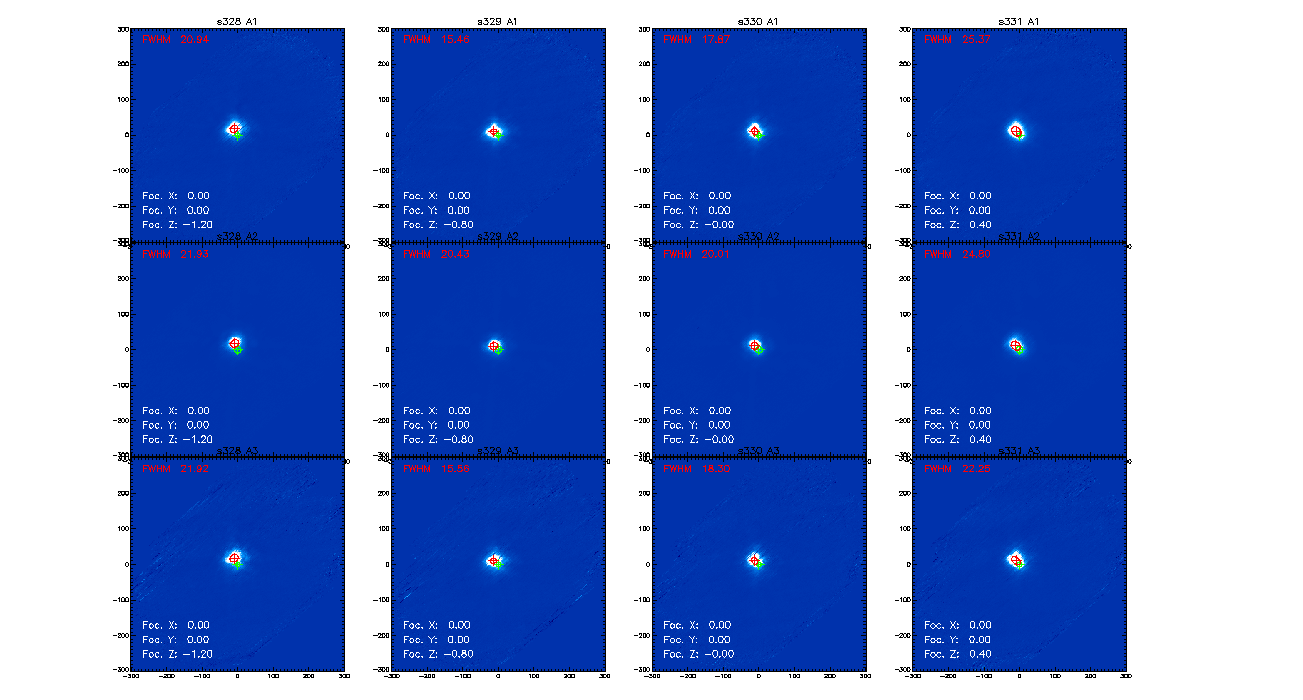
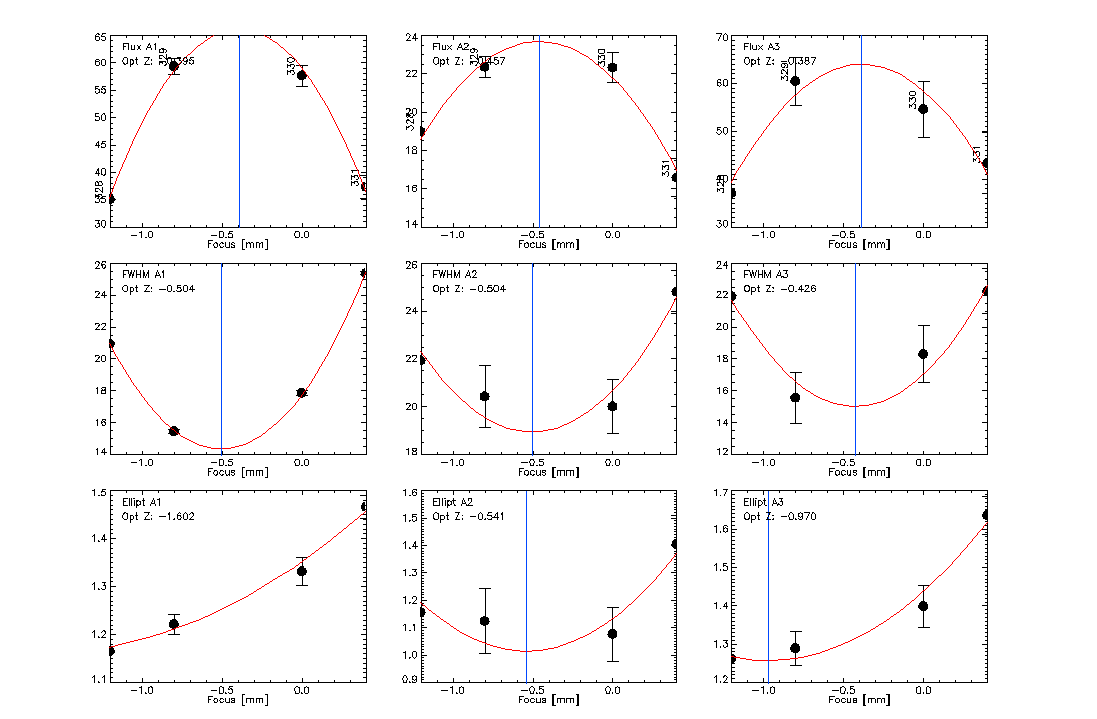
- Once the focus was as good as we could get, we did a beammap that allowed to derive the following offsets. See the lack of precision on the offsets due to instrument and weather conditions:
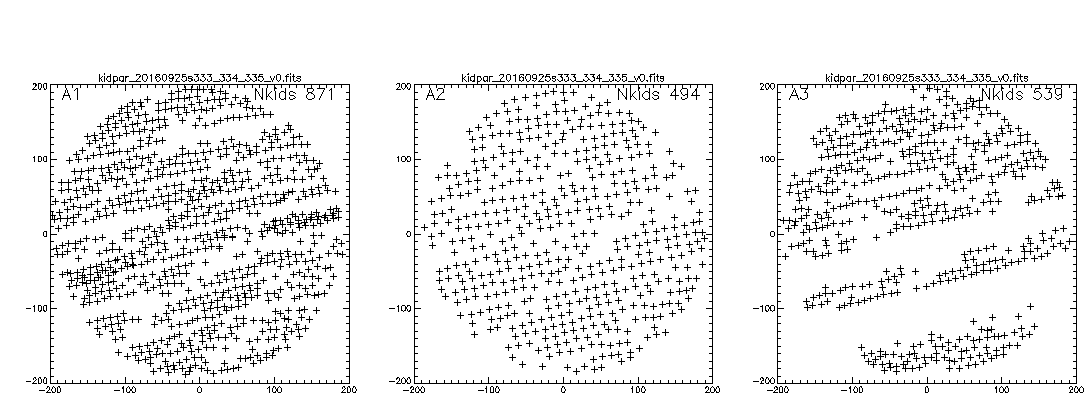
- Using the central beammap, we tested for desynchronizatino (a.k.a zigzag effect) between NIKA2 and the telescope, and could see no evidence of it on the combined map. A more detailed analysis will be per kids on more stable data, this is just an illustration. The plot shows, as a function of an artificial delay in msec, the distance between the centroids when only forward or backward scans are projected.
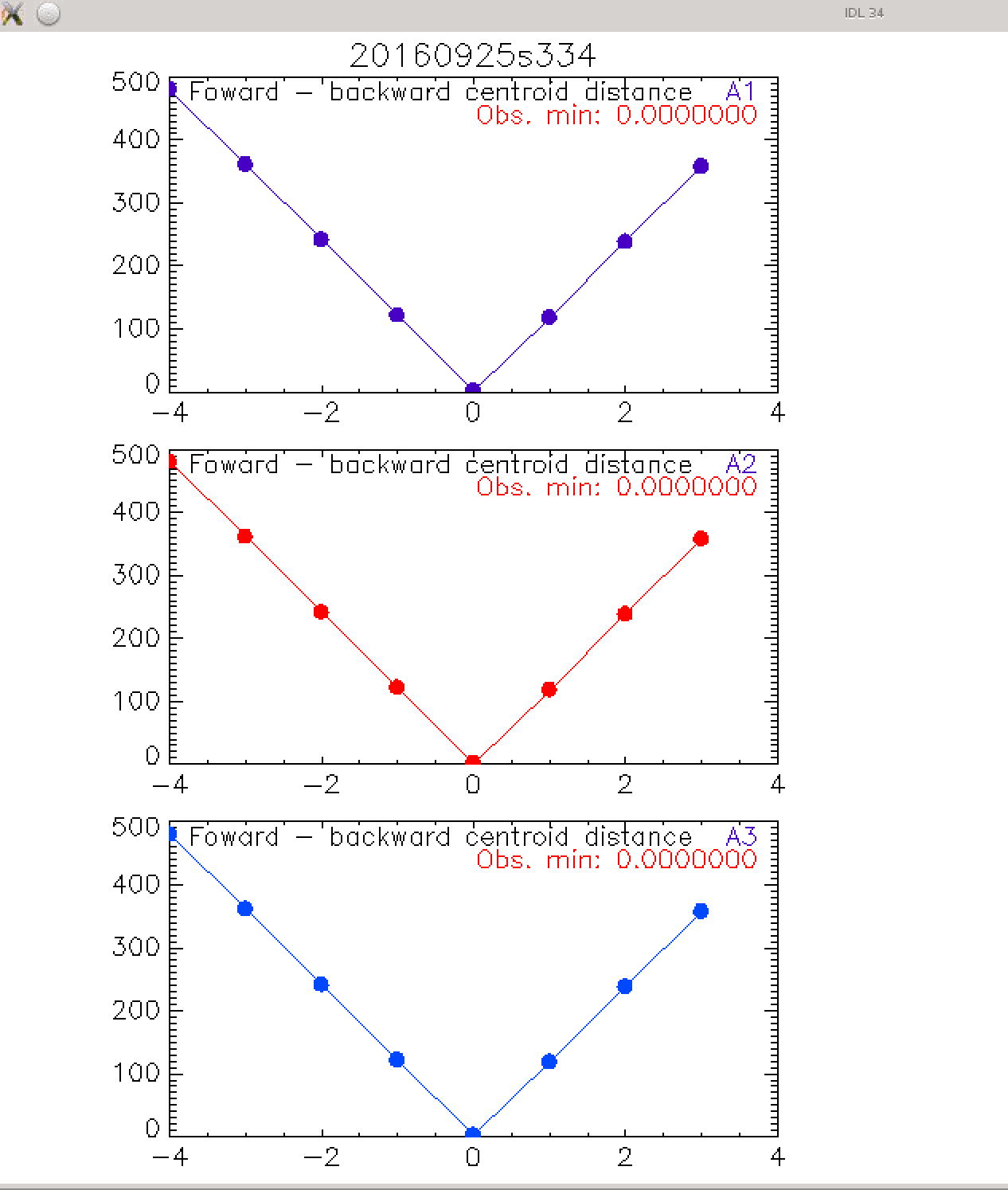
* We had a second session tonight, a few problems with files at the beginning but Juan and Alain solved the problem. The 2mm is better tuned than this afternoon. We made a few observations on Neptune, including a beammap and then moved to Uranus to perform another beammap in particular. We'll end the session by a short observation of MWC349 or a another calibrator to see if we already have hints on the FWHM difference between planets and less bright sources like we saw in the previous run.
September 24, (Saturday)
- At 10h the mixing chamber is around 15K, the condensation should start in a couple of hours if everything goes well. Plan then: check if the arrays are connected (while condensing), connect the 40 cables on the cryostat, test during the afternoon slot the system (SW, elvin etc.), then go on Sky tonight if we see the resonances.
- We have a 3 hour slot this afternoon, although not cold, we check scripts and the acqusition. Nico has produced two new pako scripts that he's happy to check. But for the resonnances that are not there, the online analysis IDL software is working fine.
* 13h30. Start condensation.
* 17h. Cold enough for us to check the feedlines. ALL THE 20 ARE CONNECTED !!!! Finally good news. However, we still wait to see which temperature the cryostat will reach. So far around 1.1K, still condensing the mixture in the trap.
* 20h. The small traps got blocked immediately. I switch to the big one. I have connected all the 40 cables on the cryostat.
* 22h. The good news is that the cryostat reached 300mK (still at 1.2K), enough to see the resonances and probably to acquire a geometry tomorrow. I try before the night to pump the helium remained trapped in the small trap that is blocked but not entirely. Done at 22h25, I re-condense the 50 mbars of mixture that are back into the reserve.
September 23, (Friday)
- Cryostat cooling down gently. A few problems with electronics and informatics. The readout boards lose the connection from time to time, more often when the tones are generated. Sometimes an entire rack switches off (usually rack 1 192.168.1.150). The "acqui" program stops when this happens. The nika2-a VNC on archeops8 stops from time to time.
- Written a script (linked on the nika2-a desktop) to launch all the instruments on nika2. When one stops better to launch everything again. To be confirmed. I also checked a bit the tones at the level of the cryostat and decided to change a bit the param to make them even flatter. Now the DAC levels are: 30,30,40,50,70.
September 22, (Thursday)
- T0+48h. T_mixing_chamber=162K; T_still=82K. T_4K_plate=35K. (was in run 1 at T0+48h: T_mixing_chamber=202K; T_still=104K. T_4K_plate=60K). This is explained by the fact that we started cooling down after the mixture washing, when the cryostat was already a bit cold.
September 21, (Wednesday)
- AB has submitted 3He via DHL to Granada.
- SN has contacted Linde-US to get green-light to order 20l 3He as spare for the future.
- T0+36h. T_mixing_chamber=205K; T_still=124K. T_4K_plate=62K. (was in run 1 at T0+48h. T_mixing_chamber=202K; T_still=104K. T_4K_plate=60K). This is explained by the fact that we started cooling down after the mixture washing, when the cryostat was already a bit cold.
September 20, (Tuesday)
- At 3h the cryostat is pumped from the air trapped. According to the pressure inside the big pipe 60-meters, we estimte that the volume of the pipe is half that of the reserve (17 mbars in the pipe correspond to 8 mbar in the reserve.
- At 3h15 starting the real cooldown. Let's hope this time. Later this morning we should add 3He.
- Olivier arrived at the telescope. He started to work on the electronics and assemble the crates.
- Another bad new: the Néel 3He stock bottle is empty! Alessandro got in contact with Alain in order to ship some 3He supply from Grenoble ASAP. In the meantime we put a bit more 4He in the mixture (from a high pressure bottle gas we had in stock) in order to continue the cool down. Cooling down to 1K is the longest part, until then the 3He is not absolutely necessary, so hopefully the 3He will arrive just when we need it.
- IRAM Granada started the process to order soon some 3He supply, 2 pumps (replacement of the broken one + a spare), and oil filters.
- The whole electronics is mounted and ready to be tested.
- After another small accident the amount of mixture is 454mbar. Added 87mbars of 4He, waiting for the 3He. So the total amount in P3 should now be, temporarily, around 540mbars. Plan to add 40mbars in 3He. The volume of the reserve is 135 liters (measured today, we had always thought it was 100 liters). So it means around 5 liters of 3He.
September 19, (Monday)
- Spent the whole day cleaning the mixture. Used the LN2 trap from NIKA2 mounted in series in the injection. A series of technical limitations made that the procedure has been slow. The final step was a preref in which the mixture circulated 1 hour below 70K (4K injection PT). From the original 606mbar we have now 484mbars. So we have lost around 120mbars, or 1/5 of the reserve. Could have been worse considering the nature of the problem we had. Tomorrow I'll add some mixture out of the Néel group stock and try to start the real cooldown.
In the meantime Martino continued working on the Turbo pump problem, and found its cause: the cable inside the Automate box which transfer the informations in and out of the pump controller, was in fact made from 2 cables soldered together, at the soldering junction some insulation layer was missing around the various wires contained in the cables, causing 3 of them to be in contact with each other. One is a ground, which must have entered in contact with the others while working on the MPPSYNC. Isolating the wires allowed to recover the control of the pump (and fix an old patch in the LabView program that had been necessary to write for a proper communication without knowing that it was the short cut between 2 wires that made it necessary).
- Martino and Johannes left with the CNRS truck in the afternoon.
September 2016, 18 (Sunday)
- Bad day: the 3He pump exploded (part of the chamber broke violently opening to air a sealed section and letting leak all its oil), most probably caused by an overpressure due to a blocked oil filter. We don't know how much 3He we lost, we're working hard to try to clean the He gas and circuitry from possible air contamination. At best the cool down of the cryostat is delayed by few days. At worst the run is cancelled.
- Before this big event, Martino and Alessandro were working on the communication problem with the 3He turbo pump. Martino found a way to communicate directly with the pump to switch it on and off, but impossible to change the speed. He was continuing investigating the problem, when the 3He pump exploded.
September 2016, 17 (Saturday)
- Finish mounting NIKA2 back in place. Everything went fine and smoothly, without problem.
- Start leak tests.
- Zemax simulations done. Ray tracing figures look scary, but it's the PSF that matters:
For the defect on the 1K lens: ~1/3 of the image surface is affected (top side); extra aberrations appear in the side lobes at ~10^-2 level, the beam peak decreases by up to 6%, the encircled energy at the 1st dark ring (-13dB level of Gaussian fit) decreases by up to 5% <=> the benefit of the corrugations AR effect is cancelled out for those pixels. It seems acceptable since most of the image is not or negligibly affected; we'll see on the sky with beam maps.
For the defect on the 2 100mK lenses: 80% of the image is affected (red cross shape); extra aberrations appear in the side lobes at ~5x10^-3 level, the beam peak decreases by up to 4.5%, the encircled energy at the 1st dark ring (-13dB level of Gaussian fit) decreases by ~3.7% <=> a significant fraction of the benefit of the corrugations AR effect is cancelled out, but not all. It seems acceptable.
- Fix a communication problem with the MPPSYNC instruments inside the Automat box (above NIKA2 on the side wall). But then the 3He turbo pump (side wall above NIKA2, below Automat) is not responding any more to any command.
September 2016, 16 (Friday)
- Arrival at the telescope of Samuel.
- Unload truck dismount NIKA2 nose, roll NIKA2 body it in the corridor.
- Dismount NIKA2 body, up to the cold stage optics.
- Change the 1K lens in the corridor: remove the smooth one, place the corrugated one. See a small defect that hadn't been seen before on a section of the new corrugated lens: groove ~5mm wide, ~0.1-0.3mm deep, ~5-7cm long. Probably acceptable; decide to keep the lens, Samuel will simulate the effect with Zemax.
- Change the 100mK lenses in the servo room (floor below the receiver cabin). Here also a small known defect on 2 of the 5 lenses: ridge ~0.5mm wide, ~0.3mm high, along 2 perpendicular diameters. Before coming Samuel estimated with a simplified simulation it was acceptable, he will simulate more accurately the defect.
- Change the 2mm array: replace the 1020 KIDs array with the new 616 KIDs array.
- Change the dichroic.
- Start mounting again everything together.
September 2016, 15 (Thursday)
- Arrival at the telescope of Johannes, then Alessandro, Martino and Aurelien with the truck.
